As Hong Kong Art Week draws to a close, it might be worthwhile to consider how well it has served the local art scene, writes Chitralekha Basu.
 Luis Chan (Hanart TZ Gallery, Art Basel Hong Kong) continues to be a favorite among the modern Chinese masters. (PHOTO PROVIDED TO CHINA DAILY)
Luis Chan (Hanart TZ Gallery, Art Basel Hong Kong) continues to be a favorite among the modern Chinese masters. (PHOTO PROVIDED TO CHINA DAILY)
This year Art Central includes a special exhibition outside its ticketed area. Blue Throat — Start the Churning, is a low-key show, featuring works by 16 Hong Kong artists. Swathes of empty spaces around the exhibits help set its minimalist tone. The show provides a counterpoint to the sensory overload greeting visitors at the city’s two mega-scale art fairs — Art Central, and its more internationally visible cousin, Art Basel Hong Kong (ABHK), running simultaneously at the Hong Kong Convention and Exhibition Centre (HKCEC).
Blue Throat comes with an unconventional layout. An unexpected turning leads to a small, shadowy enclosure with a video installation playing on a retro TV set placed on the floor. A narrow flank of the wall leading to the antechamber is the site of an artwork by Gerosa Alberto Ying Bo. Called Thy Lane Museum, the display includes satellite photos of sections of the Hong Kong coastline built on reclaimed land, besides mock-up logbooks, digging tools and artist’s renderings of large-scale, futuristic industrial constructions.
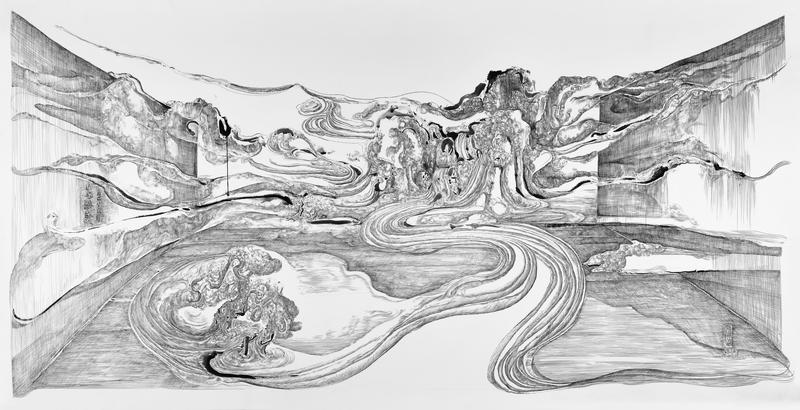 Detail from painting by Lin Guocheng (Alisan Fine Arts, ABHK), who challenges the conventions of the Chinese literati form. (PHOTO PROVIDED TO CHINA DAILY)
Detail from painting by Lin Guocheng (Alisan Fine Arts, ABHK), who challenges the conventions of the Chinese literati form. (PHOTO PROVIDED TO CHINA DAILY)
A shadow of loss — of the natural habitat of marine life in the case of Thy Lane — looms over other Blue Throat projects as well. The key idea, however, as co-curator Chris Wan explains, is to “understand pain and learn how to coexist with it”. The show’s title references an episode in Hindu mythology where the ocean was churned in search of the coveted elixir but yielded poison instead. It was left to Lord Shiva to swallow the venom before it could spread and destroy all life on earth. His throat turned blue as a result.
The narrow alley in the exhibition space is “designed to present the concept of a throat,” says Wan. “Some artworks do need a narrow space to recreate feelings of intimacy and danger.”
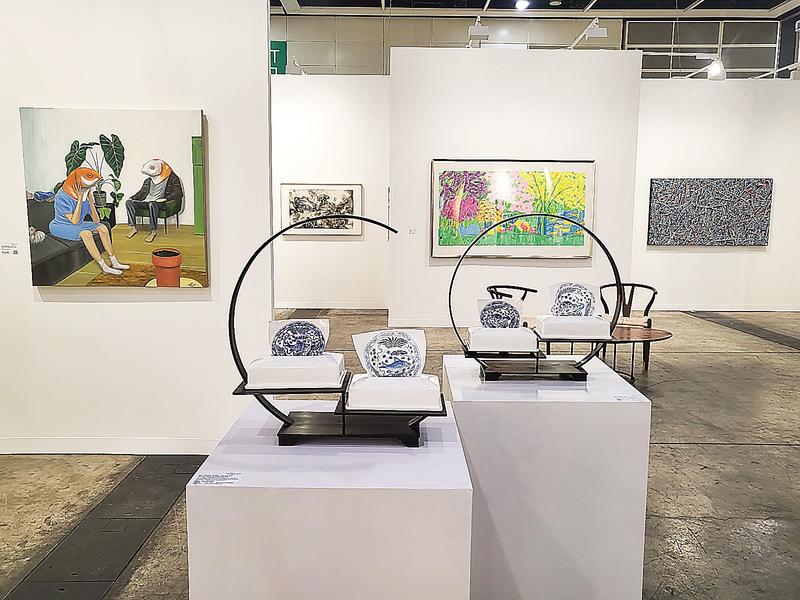 Ant Ngai has reimagined Hong Kong’s mythical creature Lo Ting as familiar, domesticated modern human beings (Alisan Fine Arts, ABHK). (PHOTO PROVIDED TO CHINA DAILY)
Ant Ngai has reimagined Hong Kong’s mythical creature Lo Ting as familiar, domesticated modern human beings (Alisan Fine Arts, ABHK). (PHOTO PROVIDED TO CHINA DAILY)
 Mak2’s triptych paintings of modern life (Peres Projects, ABHK), done in vivid colors, are popular with art fair visitors this season. (PHOTO PROVIDED TO CHINA DAILY)
Mak2’s triptych paintings of modern life (Peres Projects, ABHK), done in vivid colors, are popular with art fair visitors this season. (PHOTO PROVIDED TO CHINA DAILY)
Elsewhere in the show, Maggie Chu has created a little world full of delicate animal shapes. Made out of scrap — paper, postcards, cardboards, cement, clay, steel wire — these, mostly reptilian, creatures are about to crawl out of a suitcase and into a dystopian representation of Hong Kong. The city’s iconic skyline has been hollowed out from picture postcards pasted on the wall. Wan says this fictional landscape in Chu’s Barren Rocks Reminiscences is “not only about Hong Kong” though. Rather, “it is about understanding the human condition,” he clarifies.
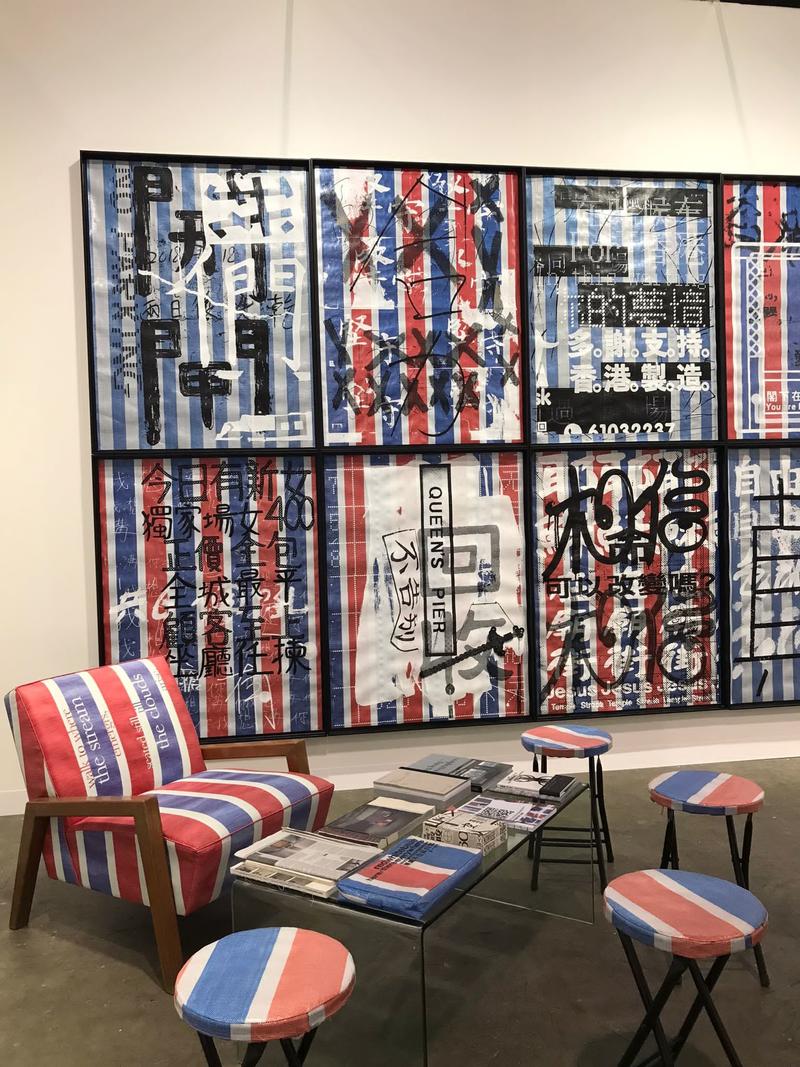 Stanley Wong (Lucie Fine Arts, ABHK) has used the tri-color code of Hong Kong’s generic plastic packaging material in many of his designs. (PHOTO PROVIDED TO CHINA DAILY)
Stanley Wong (Lucie Fine Arts, ABHK) has used the tri-color code of Hong Kong’s generic plastic packaging material in many of his designs. (PHOTO PROVIDED TO CHINA DAILY)
Common ground
As Hong Kong Art Week draws to a close, it’s time to reflect on what the city’s flagship annual cultural event achieved on behalf of its resident artists and the local art scene. A focus on Hong Kong artists presented as collectives might be a trend this year. One of the most high-profile of these being the showcase at ABHK’s UBS Lounge, featuring works by artists at the forefront of the city’s contemporary art scene — Tsang Kin-wah, LeeLee Chan and Lee Kit, among others. A relatively newer, but no less sought-after, name in the mix is that of Stephen Wong Chun-hei, known for giving his acrylic-on-paper landscape paintings a top spin. His works exude a video game vibe, acheived by using a psychedelic color palette and extreme color saturation.
Asia Art Archive (AAA) invited another set of Hong Kong heavyweights — C&G, Leung Chi Wo, Tozer Pak Sheung Chuen, Wong Wai Yin, Ricky Yeung Sau Churk, and Samson Young. Each was asked “to create a portrait” of a fellow artist, using materials from the archive’s collections, leading to a show and public talks at AAA’s ABHK booth.
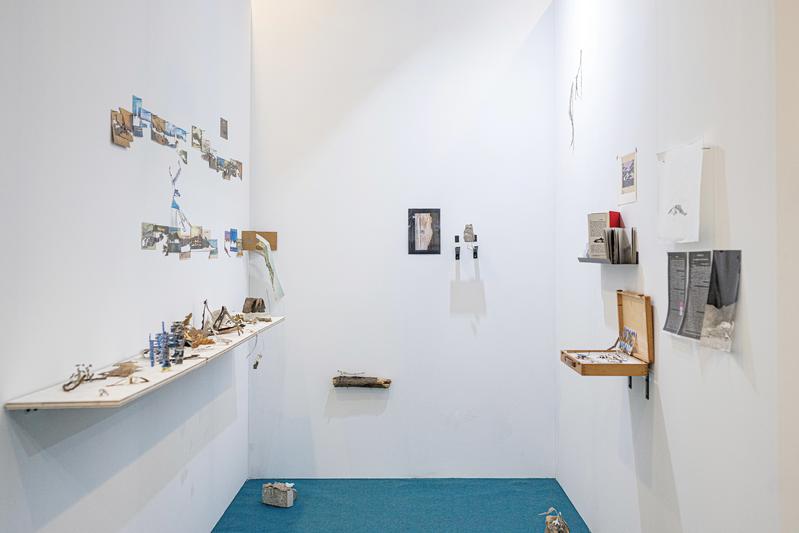 Maggie Chu creates a dystopian landscape from scrap in Barren Rocks Reminiscences (special exhibition, Blue Throat: Start the Churning, Art Central). (PHOTO PROVIDED TO CHINA DAILY)
Maggie Chu creates a dystopian landscape from scrap in Barren Rocks Reminiscences (special exhibition, Blue Throat: Start the Churning, Art Central). (PHOTO PROVIDED TO CHINA DAILY)
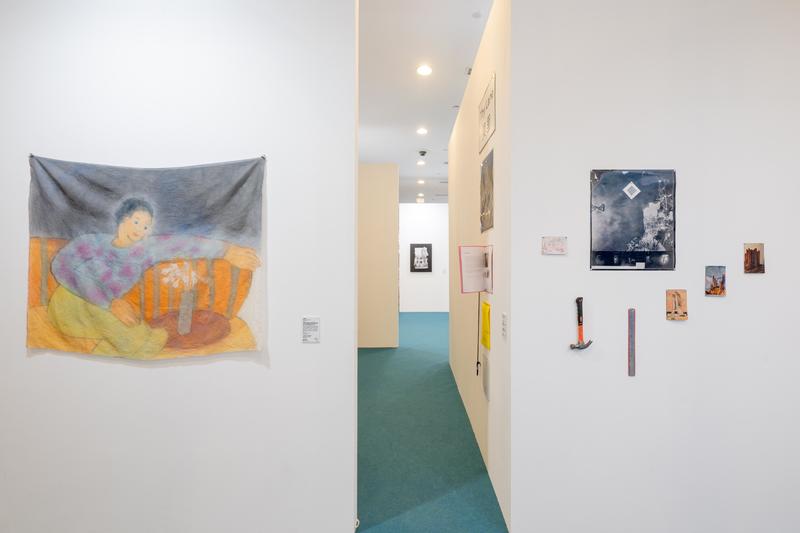 At the same exhibition, Gerosa Alberto Ying Bo casts a sideways glance at land reclamation in his Thy Lane Museum. (PHOTO PROVIDED TO CHINA DAILY)
At the same exhibition, Gerosa Alberto Ying Bo casts a sideways glance at land reclamation in his Thy Lane Museum. (PHOTO PROVIDED TO CHINA DAILY)
Dedicated to nurturing and promoting new Hong Kong talents, HART is taking advantage of the international attention attracted by Hong Kong Art Week by putting on an exhibition at its H Queen’s gallery in Central. The independent, nonprofit platform supports a bunch of creative people working as a community at HART Haus, its shared studio space in Kennedy Town.
Postmodern Tales comprises a selection of works by 10 of HART Haus’s 26 resident artists. The idea, as director Vera Lam puts it, is “to showcase the values and ongoing commitment of HART to provide an experimental and organic platform for Hong Kong-based artists” to an international audience.
Evidently, HART has created a space where hidden potentials are unlocked. For instance, poet Nicholas Wong has turned artist with HART’s support. For Postmodern Tales, he copied the words from hundreds of rejection notes received from different publications, creating layer upon layer of overwriting until the letters were indecipherable, having merged into blocks of color.
 Fatina Kong’s (Contemporary by Angela Li) luminous circular landscapes take off from the traditional Chinese form. (PHOTO PROVIDED TO CHINA DAILY)
Fatina Kong’s (Contemporary by Angela Li) luminous circular landscapes take off from the traditional Chinese form. (PHOTO PROVIDED TO CHINA DAILY)
Also featured in the show is Merryn Trevethan’s ode to the density and verticality of Hong Kong’s urban landscapes. It’s as if the Australian-born, Hong Kong resident has recreated a page of architectural drawings in 3D, and dyed it in neon colors, inviting the viewer to take a walk through the surreal landscape.
Until Further Notice “embodies a collection of Trevethan’s fragmented impressions and navigation of the city during her arrival in Hong Kong at the beginning of COVID-19,” Lam reveals. She goes on to explain the intricate and painstakingly detailed process involved in putting the work — which, from certain angles, could look deceptively simple, like an assemblage of kids’ building blocks — together. “Composed of washi tape drawings that the artist did on site, vibrant paintings and line drawings, light boxes, sculpture and video projection, the work reflects her two-year observational art practice centered on urban wanderings and the shift of perspectives while navigating public spaces,” Lam says.
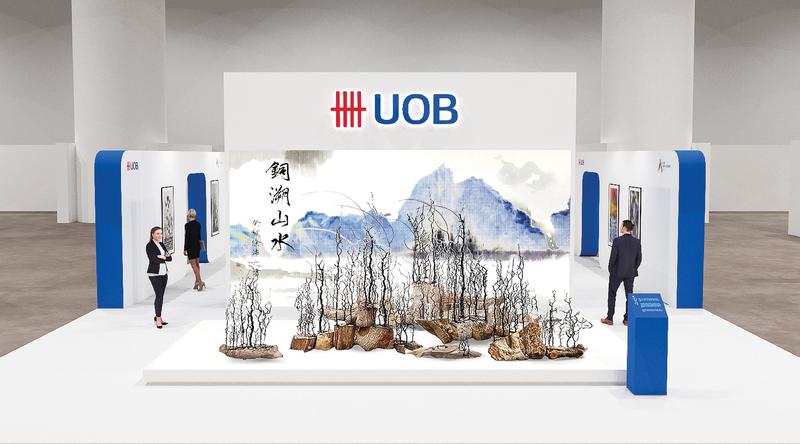 Margaret Yeung created a 3D walk-through version of traditional Chinese literati ink paintings by installing a sculpture made out of uprooted tree trunks and recycled copper wire and putting an animated digital screen in the background (UOB Art Space, Art Central). (PHOTO PROVIDED TO CHINA DAILY)
Margaret Yeung created a 3D walk-through version of traditional Chinese literati ink paintings by installing a sculpture made out of uprooted tree trunks and recycled copper wire and putting an animated digital screen in the background (UOB Art Space, Art Central). (PHOTO PROVIDED TO CHINA DAILY)
Hong Kong heartbeat
Unsurprisingly, the city itself continues to provide both subject and inspiration to many of its artists. Stanley Wong adapted the red, white and blue stripes of Hong Kong’s generic plastic packaging material, making the color combination his personal signature. An Insights booth at ABHK, hosted by Lucie Chang Fine Arts, is showcasing works by the artist who applies the tri-color code to just about everything he designs, from upholstery to ceramic vases.
Ant Ngai Wing-lam’s reimaginings of Hong Kong’s own mythological creature Lo Ting — a human figure with a fish head — as domesticated beings who could be standing by a canal, taking in the view or sitting together in a living room have found a fan base. Some of these are on show at Alisan Fine Arts’ display at ABHK.
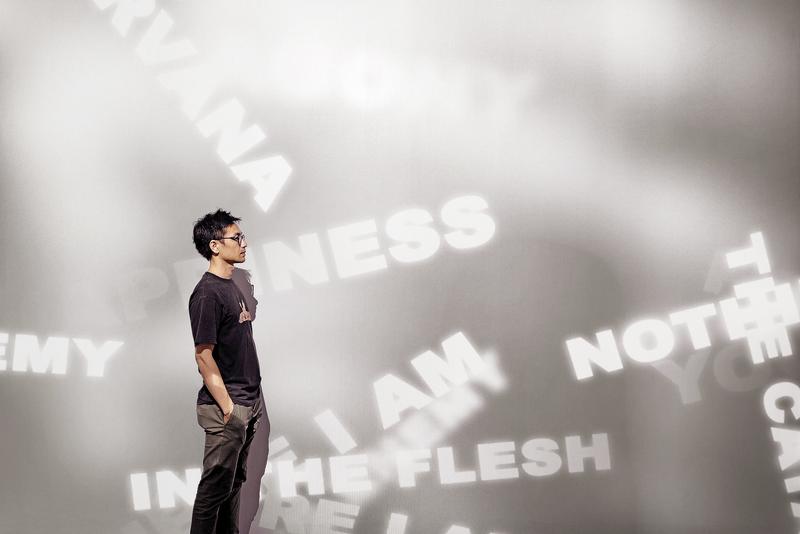 Visual artist Tsang Kin-wah is the flavor of the season. He created a site-specific piece of wall art for Art Basel Hong Kong’s UBS Lounge, figures in the fair’s Galerie du Monde booth and will soon have a large-scale projection installation opening at the Hong Kong Museum of Art. GBA briefs
(PHOTO PROVIDED TO CHINA DAILY)
Visual artist Tsang Kin-wah is the flavor of the season. He created a site-specific piece of wall art for Art Basel Hong Kong’s UBS Lounge, figures in the fair’s Galerie du Monde booth and will soon have a large-scale projection installation opening at the Hong Kong Museum of Art. GBA briefs
(PHOTO PROVIDED TO CHINA DAILY)
“In recent years, overseas collectors have been very interested in Ant’s surrealist oil paintings,” says Alisan’s director Daphne King. “In 2021 we exhibited her oil paintings in a group exhibition of Chinese surrealists co-organized with Le French May. They were very well received. Ant’s oil paintings were also collected by overseas collectors at last year’s ABHK.”
For Alisan, the ongoing art week also presents an opportunity to introduce artists from the Chinese mainland to local and international audiences. Alisan’s highlight artist this year is Lin Guocheng, a Guangdong-born painter who challenges the conventions of Chinese literati paintings. Lin invests the spiritual core of Chinese ink traditions, using a craft akin to western techniques of etching, often veering into abstraction, or interpolating an otherwise monochromatic canvas with an incongruously cheerfully colored element.
“Lin’s magnificent landscapes are created not with brushes, but with pen and ink on watercolor paper. The entire image is composed of fine, short, and rapid lines, which drive a kind of natural energy, or Qi, through the mountains and rivers that is not normally seen,” says King, adding that ABHK audiences have warmed up to Lin’s unique visual vocabulary representing the natural world. “In this dizzyingly huge art fair, the audience found Lin’s work to be a source of clarity and they were happy to take their time and appreciate the beauty of the brushwork.”
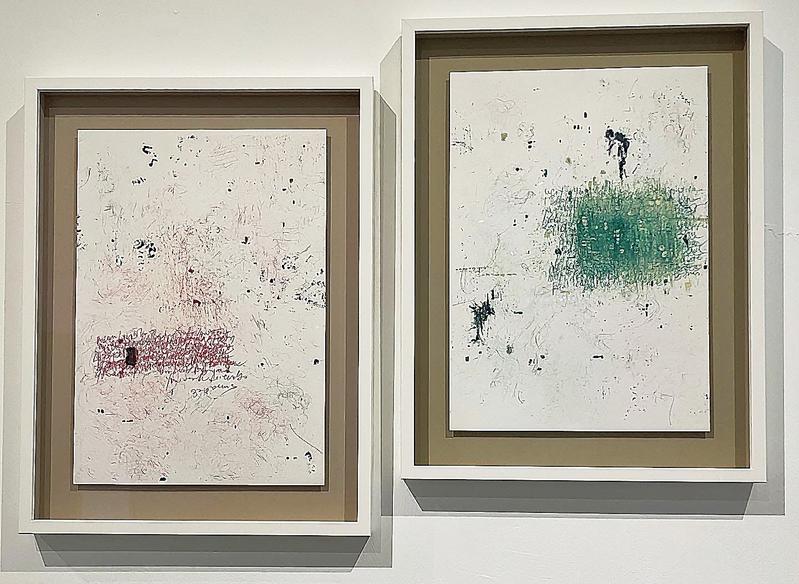 Scenes from Postmodern Tales at HART gallery in H Queen’s, Central. Nicholas Wong copied lines from rejection letters, overwriting until the words were indecipherable in his artworks. (PHOTO PROVIDED TO CHINA DAILY)
Scenes from Postmodern Tales at HART gallery in H Queen’s, Central. Nicholas Wong copied lines from rejection letters, overwriting until the words were indecipherable in his artworks. (PHOTO PROVIDED TO CHINA DAILY)
Also offering a modern take on Chinese ink landscape tradition is Margaret Yeung. For the UOB Art Space at Art Central, Yeung has created a large-scale, immersive 3D version of a literati painting that viewers can walk through. The physical component of the installation is made entirely out of found material such as trunks and branches of trees uprooted by typhoons and copper wire, deftly crafted to look like brush strokes in a traditional ink landscape painting from a distance. This elaborate sculpture is placed against an animated digital background to complete the look.
Yeung says the digital element in the piece was incorporated because “an artistic creation should have the characteristics of the time it is made in”. “While we respect the traditional Chinese ink aestheticism, we can weave it with technology to open up the dynamics and cultivate a hybrid and contemporary form of Chinese ink art.”
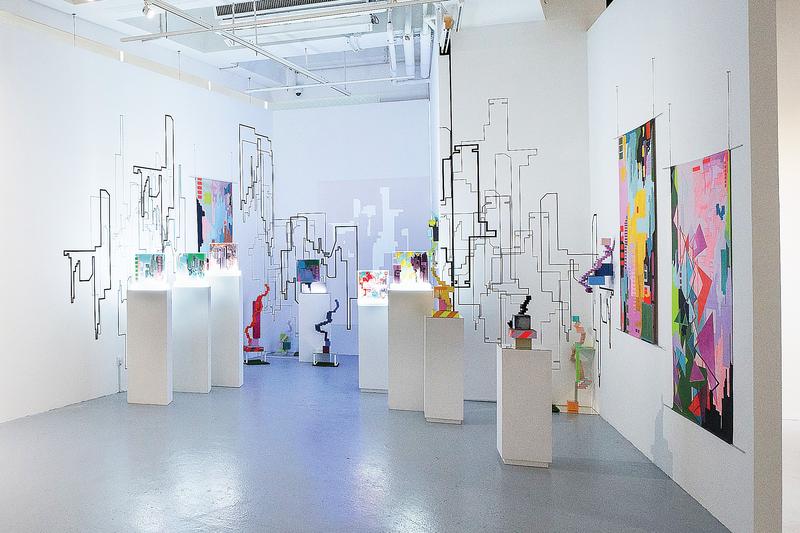 Scenes from Postmodern Tales at HART gallery in H Queen’s, Central. Merryn Trevethan makes architectural drawings come to life in her ode to Hong Kong’s urban landscape. (PHOTO PROVIDED TO CHINA DAILY)
Scenes from Postmodern Tales at HART gallery in H Queen’s, Central. Merryn Trevethan makes architectural drawings come to life in her ode to Hong Kong’s urban landscape. (PHOTO PROVIDED TO CHINA DAILY)
Stellar lineup
While collectors of the modern masters from Hong Kong, or with a strong Hong Kong connection, like Luis Chan (Hanart TZ Gallery), Walasse Ting (Alisan Fine Arts) and Wesley Tongson (Galerie du Monde), need look no further than ABHK, Art Central is known for its focused approach to discover and support fresh talent from the city. Contemporary by Angela Li, for instance, has been perennially on the lookout for newer artists to nurture and showcase. Their list this year includes new entrant Fatina Kong whose luminescent landscape paintings catch the viewer’s eye for their soft colors and circular framing. Other noteworthies include Chan King-long and Wong Sze-wai, both interested in the themes of decay and loss.
If visibility is the measure of star power, Tsang Kin-wah and Mak2 (Mak Ying Tung2) are the flavors of the season. Both figure in ABHK’s UBS Lounge, as well as elsewhere. Mak2’s signature triptychs featuring modern life painted in vivid colors are in both ABHK (Peres Projects, De Sarthe Gallery) and Art Central. Tsang is part of Galerie du Monde’s ABHK showcase, gearing up for the opening of his next big project: a large-scale projection installation, inspired by the Xubaizhai collection at the Hong Kong Museum of Art, later this month. The man who makes visual art out of written words, lending them a biomorphic fluidity, making them pour down walls or entwine like creepers only he knows how, continues to find newer ways to enthrall his viewers.


